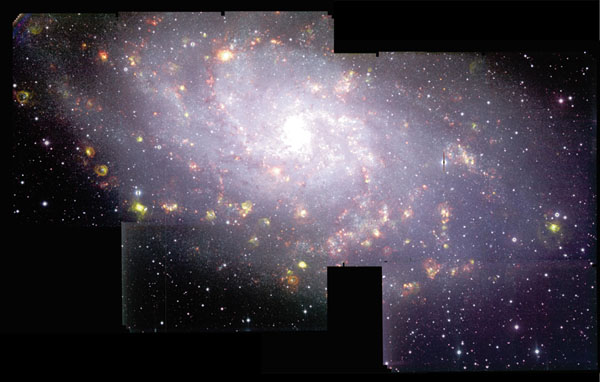| THE ING NEWSLETTER | No. 2, March 2000 |
|
|
SCIENCE |
|
|
|
| Previous: | The Sakurai Object: A Case Study in Advanced Stellar Evolution | Up: | Table of Contents | Next: | The One Eye that Sees All: Integral Field Spectroscopy with SAURON on the WHT |
Other available formats: PDF | gzipped Postscript
Another View of M33
Romano Corradi (ING)
This image of Messier 33 was obtained with the mosaic CCDs of the Wide Field Camera at the INT telescope. The authors are L. Magrini and M. Perinotto (University of Florence, Italy), R. Corradi (ING), and A. Mampaso (IAC). The image is a composition of frames taken in three narrow bands: the green colour represents the galaxian emission in a filter centred on the [OIII] nebular line at 500.7nm, red is the H-alpha hydrogen emission at 656.3nm, while blue is mainly stellar light taken through a continuum filter centred at 555.0nm (Stromgren Y). In only one observing night, and with two positionings of the telescope, it was possible to cover the whole galaxy which has a size of approximately one degree in the sky.
The main scientific goal of these
observations was to search for planetary nebulae in this nearby galaxy.
They are recognised as emission-line objects with generally intense [OIII]
and H-alpha lines, negligible continuum emission, and a point-like appearance
(1 arcsec corresponds to about 4 pc at the distance of M33). 134 newly
discovered planetary nebulae were selected, but these observations also
contain a large amount of information about other ionised nebulae, such
as HII regions, supernova remnants, Be stars, symbiotic
binaries, Wolf-Rayet stars, LBVs, etc. Their excitation status can be estimated
by using the ratio between the [OIII] and H-alpha
emission. Results concerning the search for planetary nebulae are in press
on the Astronomy and Astrophysics Journal (Magrini et al., 2000).
[ JPEG | TIFF].
Very large size: [ PDF | TIFF
]
Email contact: Romano Corradi (rcorradi@ing.iac.es)
| Previous: | The Sakurai Object: A Case Study in Advanced Stellar Evolution | Up: | Table of Contents | Next: | The One Eye that Sees All: Integral Field Spectroscopy with SAURON on the WHT |
| GENERAL | SCIENCE | TELESCOPES AND INSTRUMENTATION | OTHER NEWS FROM ING | TELESCOPE TIME |
